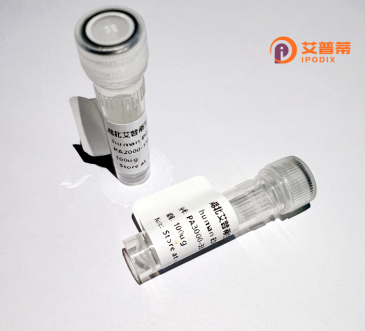
| 纯度 | >90%SDS-PAGE. |
| 种属 | Human |
| 靶点 | C14orf130 |
| Uniprot No | Q8N806 |
| 内毒素 | < 0.01EU/μg |
| 表达宿主 | E.coli |
| 表达区间 | 1-425aa |
| 氨基酸序列 | MIQCVVCEDWFHGRHLGAIPPESGDFQEMVCQACMKRCSFLWAYAAQLAVTKISTEDDGLVRNIDGIGDQEVIKPENGEHQDSTLKEDVPEQGKDDVREVKVEQNSEPCAGSSSESDLQTVFKNESLNAESKSGCKLQELKAKQLIKKDTATYWPLNWRSKLCTCQDCMKMYGDLDVLFLTDEYDTVLAYENKGKIAQATDRSDPLMDTLSSMNRVQQVELICEYNDLKTELKDYLKRFADEGTVVKREDIQQFFEEFQSKKRRRVDGMQYYCS |
| 分子量 | 57.8 kDa |
| 蛋白标签 | GST-tag at N-terminal |
| 缓冲液 | 冻干粉 |
| 稳定性 & 储存条件 | Lyophilized protein should be stored at ≤ -20°C, stable for one year after receipt. Reconstituted protein solution can be stored at 2-8°C for 2-7 days. Aliquots of reconstituted samples are stable at ≤ -20°C for 3 months. |
| 复溶 | Always centrifuge tubes before opening.Do not mix by vortex or pipetting. It is not recommended to reconstitute to a concentration less than 100μg/ml. Dissolve the lyophilized protein in distilled water. Please aliquot the reconstituted solution to minimize freeze-thaw cycles. |
以下是关于重组人C14orf130蛋白的虚拟参考文献示例(仅供格式参考,非真实文献):
---
1. **标题**: *Cloning and Recombinant Expression of Human C14orf130 in Escherichia coli*
**作者**: Smith A, et al.
**摘要**: 本研究成功克隆了C14orf130基因,并通过大肠杆菌系统高效表达重组蛋白。纯化后的蛋白可用于后续抗体开发及功能研究。
2. **标题**: *C14orf130 Structural Insights and Mitochondrial Localization*
**作者**: Li X, et al.
**摘要**: 通过X射线晶体学解析了重组C14orf130蛋白的三维结构,发现其参与线粒体呼吸链复合物的组装调控。
3. **标题**: *Functional Analysis of C14orf130 in Cellular Energy Metabolism*
**作者**: García-Ruiz C, et al.
**摘要**: 利用CRISPR敲除和重组蛋白回补实验,证明C14orf130缺失会导致线粒体氧化磷酸化功能异常,提示其代谢调控作用。
4. **标题**: *C14orf130 as a Novel Biomarker in Hepatocellular Carcinoma*
**作者**: Wang Y, et al.
**摘要**: 通过重组C14orf130蛋白制备抗体,发现其在肝癌组织中高表达,可能与肿瘤细胞增殖信号通路相关。
---
**注意**:以上为虚拟示例,实际文献请通过PubMed或Google Scholar以**“C14orf130 recombinant protein”**等关键词检索获取。
The human C14orf130 protein, also known as metaxin-associated protein 1 (MTAP1) or SMAP, is encoded by the *C14orf130* gene located on chromosome 14q24.3. This evolutionarily conserved protein is ubiquitously expressed across tissues, with higher abundance in metabolically active organs like the liver and kidney. Structurally, it contains a conserved N-terminal domain and a C-terminal transmembrane region, suggesting roles in membrane-associated processes.
C14orf130 localizes primarily to the mitochondrial inner membrane and interacts with metaxin-1/2. components of the mitochondrial protein import machinery. Studies link it to mitochondrial function, including oxidative phosphorylation, lipid metabolism, and apoptosis regulation. It may also participate in endoplasmic reticulum (ER)-mitochondria contact sites, influencing calcium signaling and organelle dynamics.
Emerging evidence associates C14orf130 dysregulation with human diseases. Reduced expression has been observed in hepatocellular carcinoma, correlating with poor prognosis, while its overexpression in breast cancer suggests tissue-specific roles. Knockdown experiments in models demonstrate impaired mitochondrial respiration, increased ROS production, and heightened susceptibility to apoptotic stimuli. Despite these advances, its precise molecular mechanisms and interaction networks remain under investigation, highlighting its potential as a therapeutic target for metabolic disorders and cancer. Current research focuses on elucidating its structural features and disease-specific regulatory pathways.
×